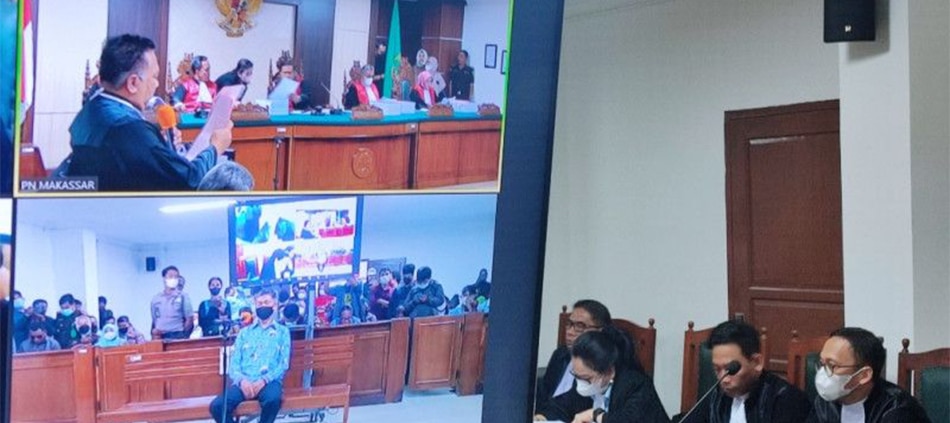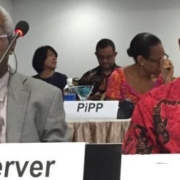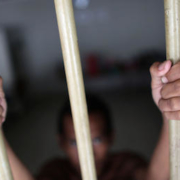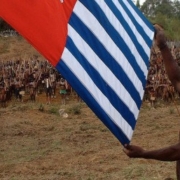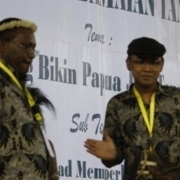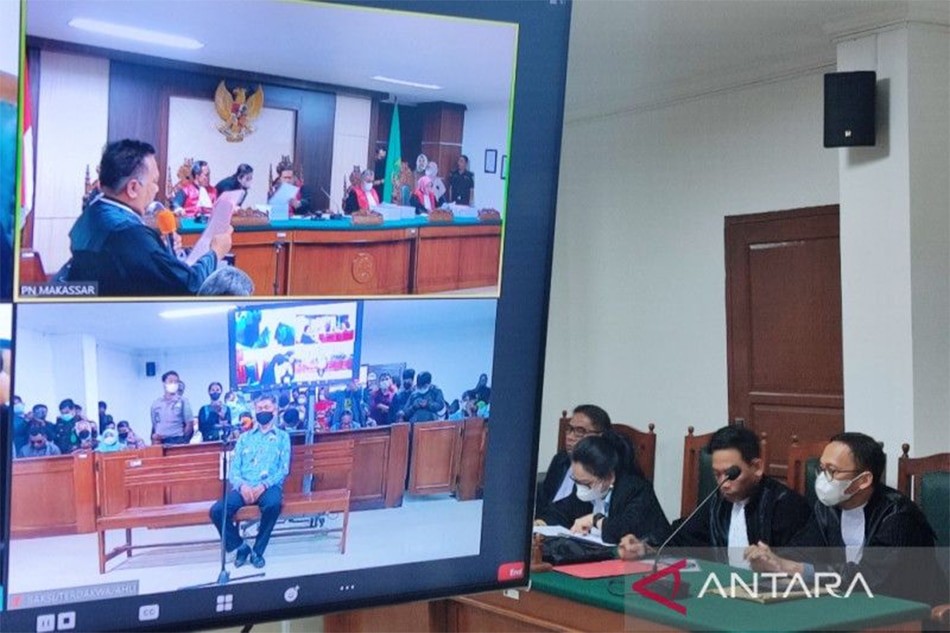
The government made efforts to ensure the trial was transparent, with hearings livestreamed on YouTube. Photo by Darwin Fatir for Antara.
Eight years after a deadly incident in Paniai, Papua, the Indonesian Human Rights Court in the Makassar District Court on 8 December found retired military liaison officer Isak Sattu not guilty of crimes against humanity.
The case hinged on determining if Isak bore command responsibility for the shooting deaths of four Indigenous Papuan teenagers and the injury of dozens of other Papuans at a demonstration incited by the beating of a group of teenagers the night before. It was the first trial in the Human Rights Court in more than 16 years.
Set against a history of colonisation and Papuan independence movements, the Paniai incident was just one instance of violence in a long-string of abuses of power and extrajudicial killings in the region. Yet, human rights abuses in Papua are almost never prosecuted. This case therefore offers valuable insight into the court’s prospects of serving as a visible and legitimate mechanism for examining other cases of human rights violations in Indonesia.
To ensure the trial process was fully documented, the authors joined a team from the Indonesian Institute for an Independent Judiciary (LeIP). The team monitored each session from the first day of the proceedings, both in-person and through an online livestream.
The trial saw improvements in some areas compared to previous human rights cases tried in the early 2000s, namely in the judges’ adjudication of the case and in efforts to improve transparency. On the other hand, the selection of Isak Sattu as a sole defendant, and the inadequate courtroom security and victim and witness protection provided hindered the court’s ability to seek accountability and uphold the rule of law.
While Isak was ultimately acquitted, the success of the Human Rights Court cannot be determined solely by this verdict. Rather, the verdict must be situated within the broader context of the political and procedural limitations that influenced the entire judicial process and constrained the court’s ability to serve as a functional accountability mechanism.
The future of the Human Rights Court process in Indonesia hinges on addressing several challenges, primarily related to the politicisation of the judicial process, procedural limitations, and minimal domestic and international civil society engagement.
Many of the difficulties that the Human Rights Court faces today are, in part, a by-product of the political motives that drove its inception. Indonesia established Human Rights Courts after facing immense international pressure, including from the UN Security Council, to seek criminal justice for crimes committed in East Timor in the late 1990s.
Then-President BJ Habibie feared that the UN would establish an international tribunal to try Indonesian military personnel. Further influenced by the wave of civil society activism at the onset of the reform period, Habibie issued Emergency Regulation in Lieu of Law (Perppu) No. 1 of 1999 (later replaced by Law No. 26 of 2000) to establish a Human Rights Court system to try those implicated in gross human rights violations.
The Human Rights Court is the only mechanism that can hold people criminally accountable under either individual or command responsibility for human rights violations. Because it can adjudicate criminal charges, the court can deliver a sense of accountability unlike non-judicial reconciliatory and victim-centred justice mechanisms. No formal non-judicial mechanism to address human rights violations in Indonesia has been active since the law establishing a Truth and Reconciliation Commission was struck down by the Constitutional Court in 2006.
Indonesian officials were well aware of threats by the international community to set up an international tribunal if the domestic court failed to deliver on its mandate. But even after a deeply flawed trial and appeals process that saw all defendants eventually acquitted, no international tribunal has ever been established. Before the Paniai case, only three cases were ever tried in the Human Rights Court, the last of which ended in 2006.
More than a decade later, President Joko “Jokowi” Widodo revived a campaign promise to settle 13 pending cases of alleged past human rights violations in Indonesia. For a president striving to boost Indonesia’s global profile, addressing these rights abuses would have helped improve the country’s flagging democratic credentials – credentials that have just been damaged by the passage of a flawed new Criminal Code (KUHP).
Activists have questioned why the Paniai trial was the first of these 13 past violations to be prioritised. The answer is probably linked to the fact that the Paniai trial began just before Indonesia underwent its UN universal periodic review last month, where rights abuses in Papua were a key focus. The trial also came just months after the national legislature passed laws establishing three new provinces in Papua, despite protests from sections of the population in Papua. It was also the only pending case of gross human rights violations that occurred during Jokowi’s presidency.
Regardless, the Paniai trial offered a rare and promising opportunity for accountability. However, it was hamstrung by political pressures and procedural limitations.
To start, the indictment for the Paniai case named a singular defendant, Isak, a retired TNI officer stationed in Paniai to coordinate with the regional government and higher divisions of the military. As a liaison officer, Isak never had formal command authority over the military officers who allegedly committed the violence. The prosecution’s decision to only charge Isak is particularly hard to understand given that a pre-investigation report suggested nine individuals, including commanders of several security units, should be charged.
Confusingly, witnesses called by the prosecution during the trial further undermined the case that the defendant was responsible under command authority. Some officers present at the scene who testified as witnesses admitted, for example, that they fired weapons without direction from Isak.
Moreover, the former head of the Enarotali Military District Command (where Isak was stationed) testified that the defendant had neither formal command authority nor de facto control over his subordinates. Witnesses also identified other members of the security forces who murdered and injured protesters, although these direct perpetrators have yet to be indicted.
The choice of just one defendant – and Isak in particular – left observers questioning if political influences had prevented other more responsible individuals from being charged. That is, whether the trial was intended to fail.
Indeed, some Papuan witnesses and community members boycotted the trial, disillusioned by perceived political influences on the trial and the selection of this single defendant.
Throughout the trial, there was a lack of sensitivity to the broader history of violence and suppression of Indigenous communities in Papua, who have long had to contend with a heavy military presence, internet shutdowns, and racist treatment by non-Papuans. For example, multiple times during the trial, a video submitted as evidence that portrayed protesters fleeing and dozens of rounds of gunshots being fired was played without a content warning, resulting in clear distress to at least one Papuan audience member.
Families of the victims were so disappointed by the trial’s shortcomings that on 1 December they sent a letter asking the UN High Commissioner for Human Rights to pressure the Indonesian government to conduct a new investigation.
The trial proceedings also suffered from a lack of adequate security and victim and witness protection. The trial was not held in the better-secured courtroom that usually houses sensitive trials because of renovations in the Makassar District Court. Our trial monitoring team’s bags were checked just twice throughout the whole trial. Further, the prosecution noted during the trial that at least one victim witness did not attend because of fears for their safety. This suggests that the Victims and Witness Protection Agency (LPSK) did not provide adequate support to the victims before and during the trial.
One notable success of the trial was its accessibility. The trial was livestreamed on YouTube, demonstrating a tangible effort to ensure that the proceedings were transparent to the public. The same could be said for the physical courtroom environment. In past cases, the gallery was filled with military officials, making it difficult for independent observers to safely attend the court hearings. But civil society representatives and students from Papua, law students, and fellow trial monitors were able to attend this trial. These efforts toward transparency demonstrated that the government was invested to some degree at least in the court succeeding as a legitimate and visible mechanism to achieve accountability.
Another encouraging sign was the performance of the judges. Despite being limited in their adjudication of the case by a faulty indictment, confusing witness and expert testimony, and scarce physical evidence, the judges made an effort to shed light on what happened during the Paniai incident and identify other suspects to be investigated. In addition, their use of international jurisprudence and application of Law No. 26 of 2000 in accordance with the Rome Statute in the judgment clarified years of confusion over the interpretation of the law.
As the dust is blown off the Indonesian Human Rights Court after years of inactivity, the Paniai trial is an important first test case. Increased engagement from both domestic and international civil society is essential to call out the significant limitations of this trial and to advocate for improved training for prosecutors and judges, independent selection of defendants, and resources for the Human Rights Court.
There is also an opportunity for international actors to raise serious concerns about how the flawed new Criminal Code treats violations of human rights, in particular its diluting of offences and punishments in the 2000 Law on the Human Rights Court. With 12 cases still pending, including for the 1965 massacre and May 1998 protests, the international community plays a key role in holding the Indonesian government accountable to its human rights commitments – not just in principle, but in practice too.


